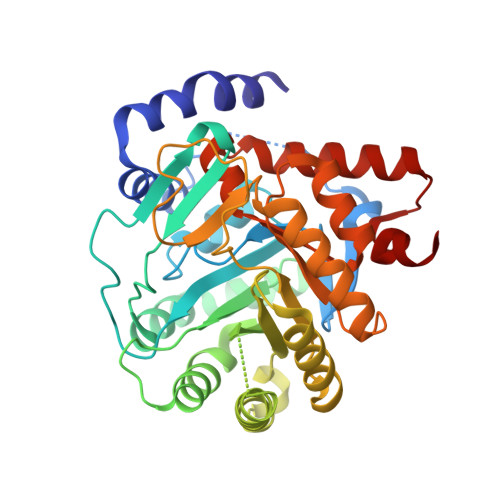Design, synthesis, biological evaluation and X-ray structural studies of potent human dihydroorotate dehydrogenase inhibitors based on hydroxylated azole scaffolds.
Sainas, S., Pippione, A.C., Giorgis, M., Lupino, E., Goyal, P., Ramondetti, C., Buccinna, B., Piccinini, M., Braga, R.C., Andrade, C.H., Andersson, M., Moritzer, A.C., Friemann, R., Mensa, S., Al-Kadaraghi, S., Boschi, D., Lolli, M.L.(2017) Eur J Med Chem 129: 287-302
- PubMed: 28235702
- DOI: https://doi.org/10.1016/j.ejmech.2017.02.017
- Primary Citation of Related Structures:
5MUT, 5MVC, 5MVD - PubMed Abstract:
A new generation of potent hDHODH inhibitors designed by a scaffold-hopping replacement of the quinolinecarboxylate moiety of brequinar, one of the most potent known hDHODH inhibitors, is presented here. Their general structure is characterized by a biphenyl moiety joined through an amide bridge with an acidic hydroxyazole scaffold (hydroxylated thiadiazole, pyrazole and triazole). Molecular modelling suggested that these structures should adopt a brequinar-like binding mode involving interactions with subsites 1, 2 and 4 of the hDHODH binding site. Initially, the inhibitory activity of the compounds was studied on recombinant hDHODH. The most potent compound of the series in the enzymatic assays was the thiadiazole analogue 4 (IC 50 16 nM). The activity was found to be dependent on the fluoro substitution pattern at the biphenyl moiety as well as on the choice/substitution of the heterocyclic ring. Structure determination of hDHODH co-crystallized with one representative compound from each series (4, 5 and 6) confirmed the brequinar-like binding mode as suggested by modelling. The specificity of the observed effects of the compound series was tested in cell-based assays for antiproliferation activity using Jurkat cells and PHA-stimulated PBMC. These tests were also verified by addition of exogenous uridine to the culture medium. In particular, the triazole analogue 6 (IC 50 against hDHODH: 45 nM) exerted potent in vitro antiproliferative and immunosuppressive activity without affecting cell survival.
- Department of Science and Drug Technology, University of Torino, via Pietro Giuria 9, 10125 Torino, Italy.
Organizational Affiliation:





















